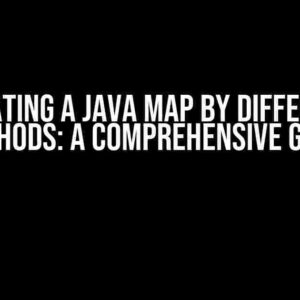As a developer, have you ever wondered how much memory your function is consuming? Understanding space complexity is crucial to write efficient code that doesn’t hog system resources. In this article, we’ll demystify space complexity and provide a step-by-step guide on how to calculate it for any function.
What is Space Complexity?
Space complexity refers to the amount of memory used by an algorithm or a function. It’s a crucial aspect of algorithm design, as it directly impacts the performance and scalability of your code. A function with high space complexity can lead to memory leaks, slow down your application, and even cause crashes.
Why is Space Complexity Important?
Imagine you’re building a web application that needs to handle a large dataset. If your function has high space complexity, it can lead to:
- Memory Leaks: Your application will consume an excessive amount of memory, causing performance issues and crashes.
- Scaledown: Your application won’t be able to handle large datasets, leading to a poor user experience.
- Bottlenecks: High space complexity can create bottlenecks that slow down your application, making it unresponsive.
How to Calculate Space Complexity
Calculating space complexity involves identifying the memory used by a function and expressing it in Big O notation. Here’s a step-by-step guide to calculate space complexity:
-
Identify the variables: Identify all the variables used in the function, including inputs, outputs, and temporary variables.
-
Count the memory usage: Calculate the memory used by each variable, considering the data type and size.
-
Express in Big O notation: Express the total memory usage in Big O notation, which is a standardized way to describe the complexity of an algorithm.
Examples to Illustrate Space Complexity
Let’s consider a few examples to demonstrate how to calculate space complexity:
Example 1: Simple Function
def single_element():
a = 10
return aIn this example, we have only one variable `a` that uses a constant amount of memory. The space complexity is O(1), which means the memory usage remains constant regardless of the input size.
Example 2: Array Function
def array_function(n):
arr = [0] * n
return arrIn this example, we have an array of size `n`, which uses O(n) memory. The space complexity is O(n), which means the memory usage grows linearly with the input size.
Example 3: Nested Loops
def nested_loops(m, n):
for i in range(m):
for j in range(n):
temp = i * j
return tempIn this example, we have two nested loops that iterate `m` and `n` times, respectively. The space complexity is O(1), as we only use a constant amount of memory to store the temporary variable `temp`.
Common Space Complexities
Here are some common space complexities and their descriptions:
| Space Complexity | Description |
|---|---|
| O(1) | Constant space complexity, where the memory usage remains constant regardless of the input size. |
| O(log n) | Logarithmic space complexity, where the memory usage grows logarithmically with the input size. |
| O(n) | Linear space complexity, where the memory usage grows linearly with the input size. |
| O(n log n) | Linearithmic space complexity, where the memory usage grows linearly with the input size, but with an additional logarithmic factor. |
| O(n2) | Quadratic space complexity, where the memory usage grows quadratically with the input size. |
Best Practices to Optimize Space Complexity
To optimize space complexity, follow these best practices:
- Avoid unnecessary variables: Remove unnecessary variables that consume memory without serving a purpose.
- Use space-efficient data structures: Choose data structures that use less memory, such as arrays instead of linked lists.
- Minimize recursive function calls: Recursive function calls can lead to high space complexity. Try to minimize them or use iterative approaches instead.
- Use lazy loading: Load data only when necessary to reduce memory usage.
Conclusion
In conclusion, understanding space complexity is crucial to write efficient code that doesn’t hog system resources. By following the steps outlined in this article, you can calculate the space complexity of any function and optimize it for better performance. Remember, every byte counts, and optimizing space complexity can make a significant difference in the scalability and performance of your application.
So, the next time you ask, “I want to know the space complexity of this function,” you’ll know exactly how to calculate it and optimize it for better performance.
Share your thoughts and questions in the comments below. Happy coding!
Frequently Asked Question
Get ready to blast off into the world of space complexity! Here are the top 5 questions and answers about determining the space complexity of a function.
What is space complexity, and why should I care?
Space complexity refers to the amount of memory an algorithm or function uses as a function of the size of the input. It’s essential to understand space complexity because it can affect the performance and efficiency of your code, especially when dealing with large datasets or limited memory resources.
How do I calculate the space complexity of a function?
To calculate the space complexity of a function, identify the variables and data structures used within the function and determine their memory usage. Then, express the memory usage as a function of the input size, usually in Big O notation (e.g., O(1), O(n), O(n^2), etc.).
Does the space complexity of a function include the input size?
No, the space complexity of a function typically excludes the input size. You should only consider the additional memory used by the function, such as variables, data structures, and auxiliary storage.
What’s the difference between space complexity and time complexity?
Time complexity refers to the amount of computational time an algorithm or function takes as a function of the input size, whereas space complexity focuses on the amount of memory used. Both are essential to understand when analyzing an algorithm’s efficiency.
Can I always reduce the space complexity of a function?
Not always. Sometimes, reducing space complexity may compromise the time complexity or overall correctness of the function. It’s essential to strike a balance between space and time complexity, depending on the specific requirements and constraints of your problem.



